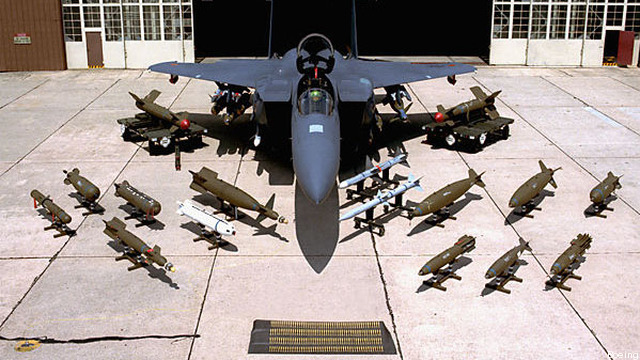 WASHINGTON: US foreign military sales are growing so fast the Pentagon can’t keep its PowerPoint slides updated — and they may well grow still more if a Defense Department policy easing exports of unmanned aircraft to 66 countries gets interagency and Congressional approval.
WASHINGTON: US foreign military sales are growing so fast the Pentagon can’t keep its PowerPoint slides updated — and they may well grow still more if a Defense Department policy easing exports of unmanned aircraft to 66 countries gets interagency and Congressional approval.
When Defense Security Cooperation Agency staff put together a briefing for DSCA deputy director Richard Genaille to give today at the National Press Club, new Foreign Military Sales (FMS) for fiscal year 2012 were at $64 billion. “It’s now $65 billion and will probably go up more in this fiscal year,” Genaille told the audience this morning at the ComDef 2012 conference. All told, Genaille said, “the FMS portfolio is valued at $385 billion dollars,” and supports “at least 3.5 million jobs, [at] a conservative estimate.”
DSCA oversees — at last count — 12,901 FMS cases involving 224 countries and international organizations. Almost every nation on Earth now buys US military gear, excepting only a handful of countries like China and Vatican City. DSCA has even started organizing inter-agency “expeditionary requirements generation teams” that visit foreign countries to help them assess their needs, define their requirements, and submit a formal “letter of request” for an arms deal to the US; the five countries visited so far include both the Philippines and Iraq.
This year’s record-breaking figures are driven not by developing-world clients, however, but by extraordinary sales to Saudi Arabia — $29.4 billion for Boeing F-15s — and Japan — $10 billion for Lockheed Martin F-35 Joint Strike Fighters. Those deals may well represent trends, not flukes, given rising anxiety among the oil-rich Gulf States over the Iranians and anxiety across East Asia over the Chinese. However, Genaille told reporters after his public remarks here that he expected sales to settle back down next year to the more usual range of $32 billion to $35 billion annually.
While manned fighters dominate today’s foreign sales, it is unmanned aircraft that could be a big growth area for the future. It’s an area where the US industry enjoys a commanding advantage, thanks to the massive expansion of the American military’s drone fleet since 9/11. Just today, Radio Australia reported that Australia was reviving its plan to buy seven long-range Broad-Area Maritime Surveillance (BAMS) drones.
But new technologies create new problems with old export control systems, especially since larger, longer-ranged drones often technically count as cruise missiles under the Missile Technology Control Regime (MTCR). Such obstacles have so far stymied Japanese and South Korean interest in the Northrop Grumman Global Hawk, as well as Italian interest in arming its General Atomics Predators.
“The good news,” said Genaille, is that Pentagon officials succeeded last year in drafting a Defense Department-wide policy on Unmanned Air Systems (UAS) exports, listing some 66 countries as eligible to buy American drones. The effort was led by DSCA’s new Strategic Planning Support Group” and the Pentagon’s Technology Security and Foreign Disclosure Office (TSFDO). Bragged Genaille, “nothing like that has been accomplished for DoD [the Department of Defense] before.”
The bad news, Genaille went on, is that “while we have a DoD policy on exports of UAS, we don’t really have a comprehensive US government policy.” The Pentagon is still working with the State Department and Congress, he said. “It hasn’t moved quite as fast as we would like, but we’ve not given up and we’re going to to continue to work on that,” he pledged. “There will be action on those issues; I can’t promise there’ll be approval.”

